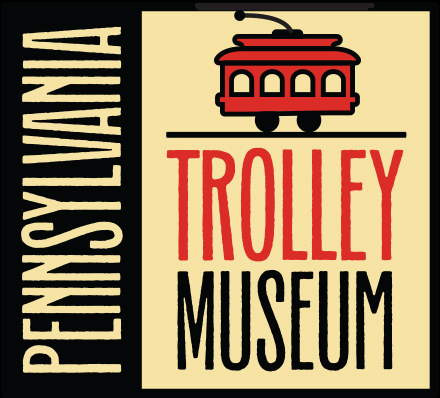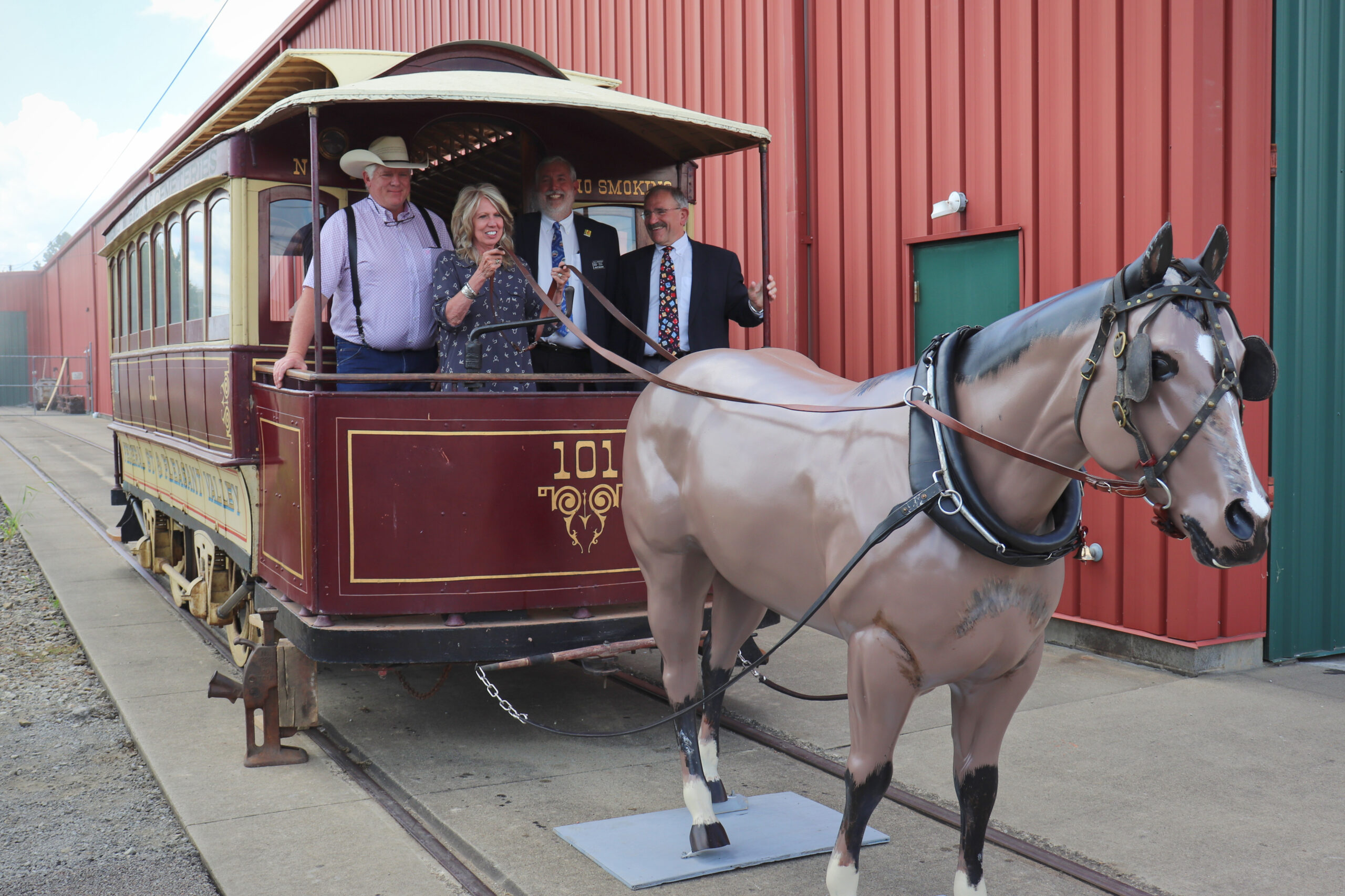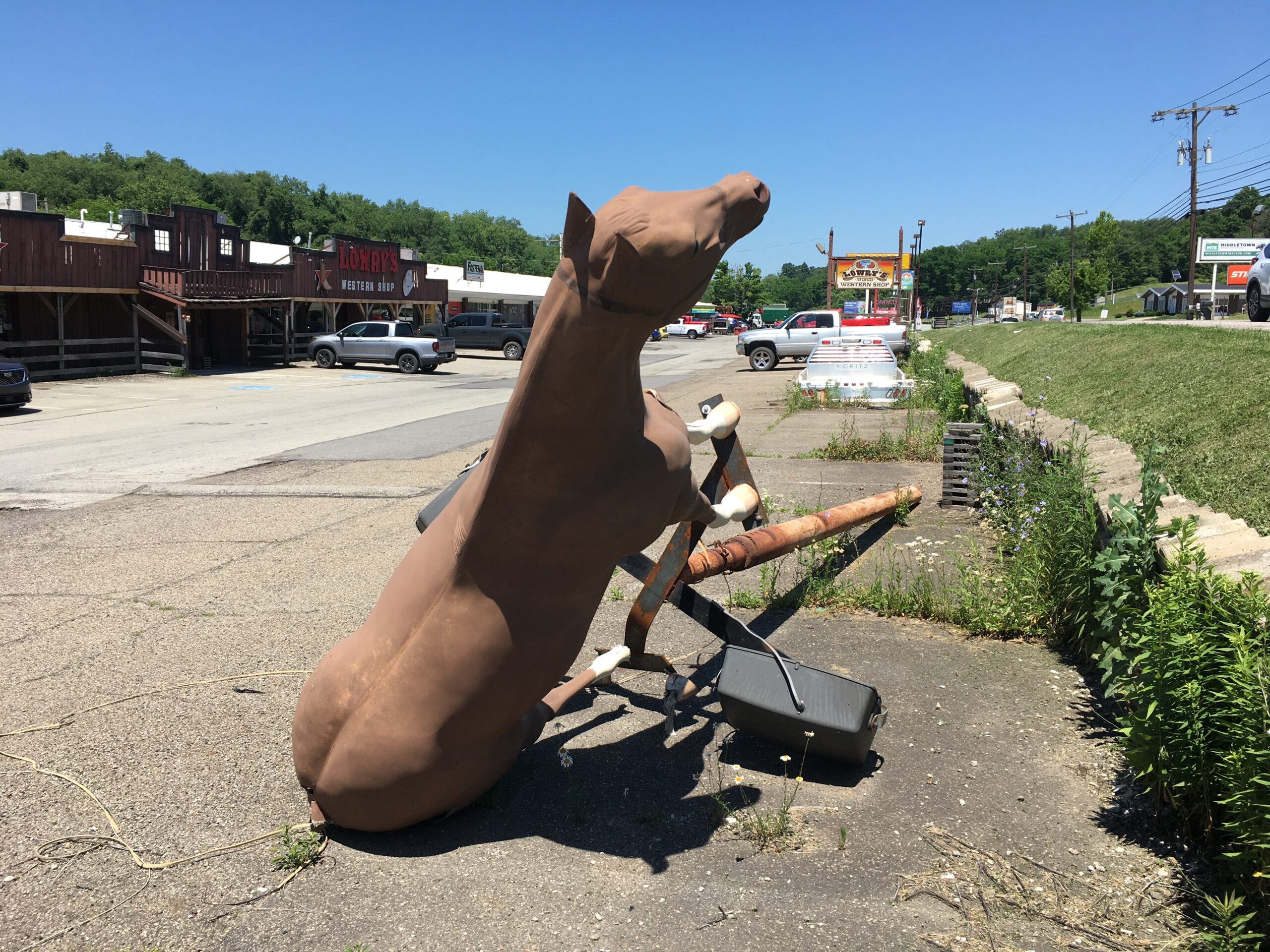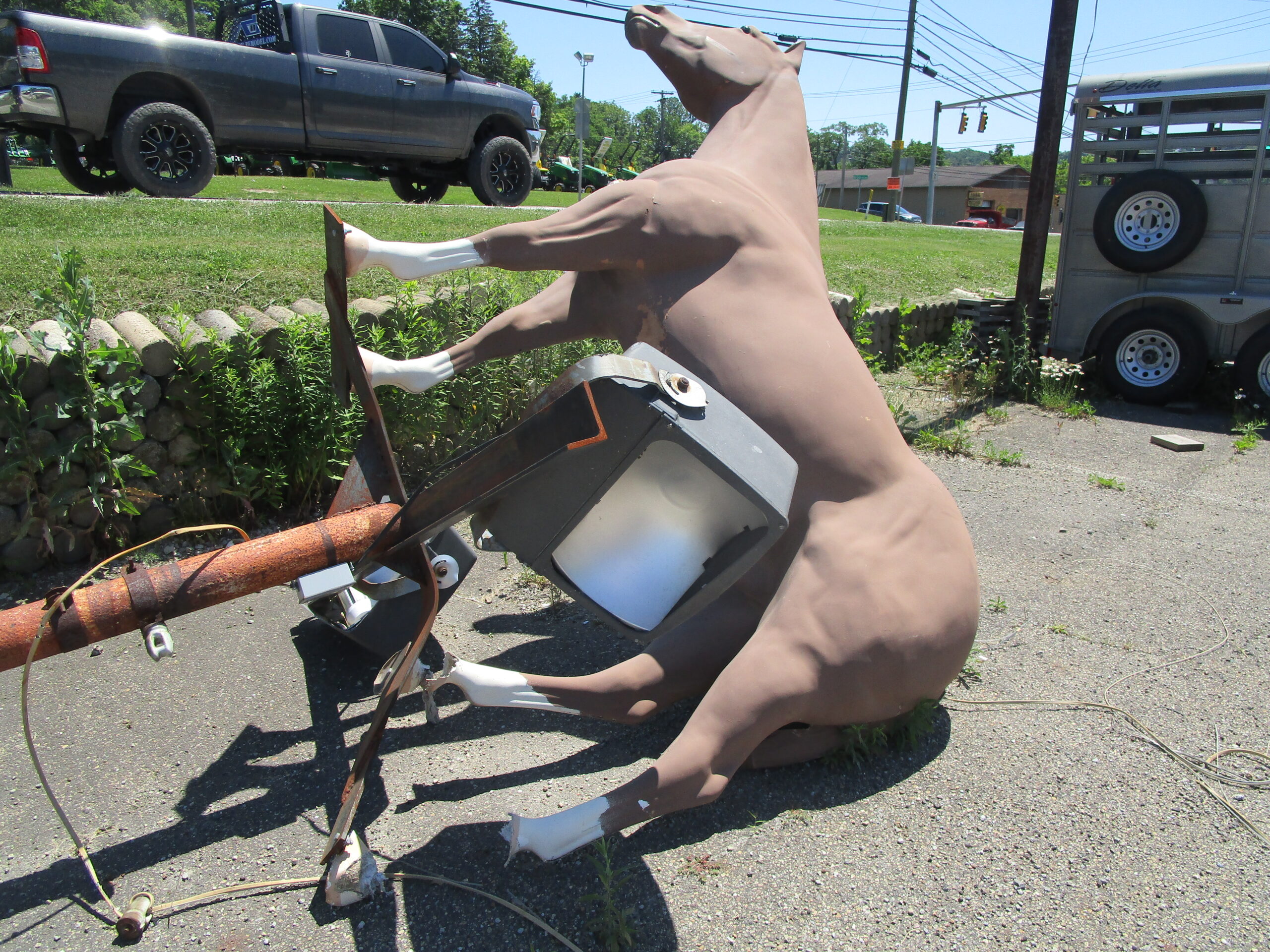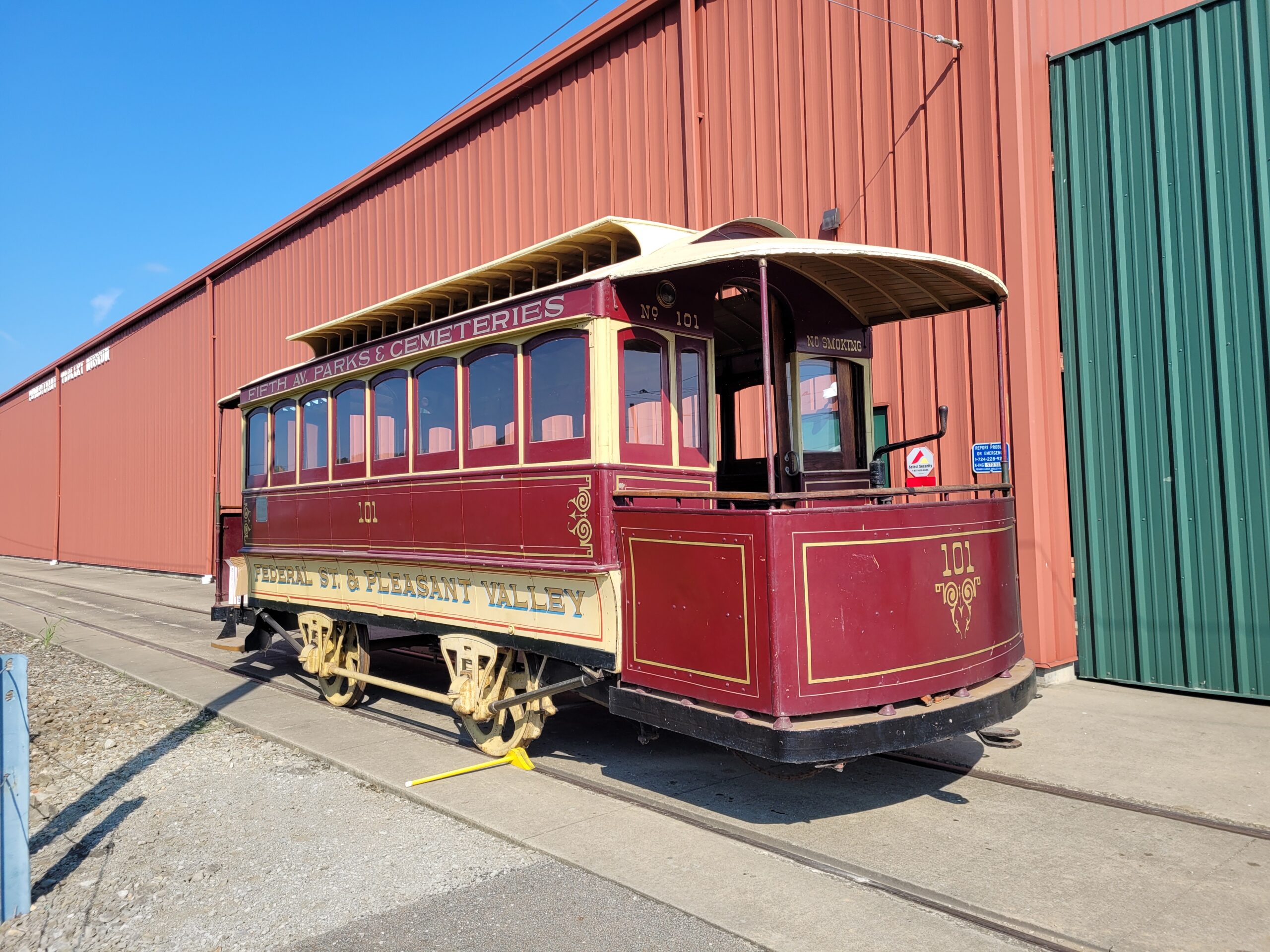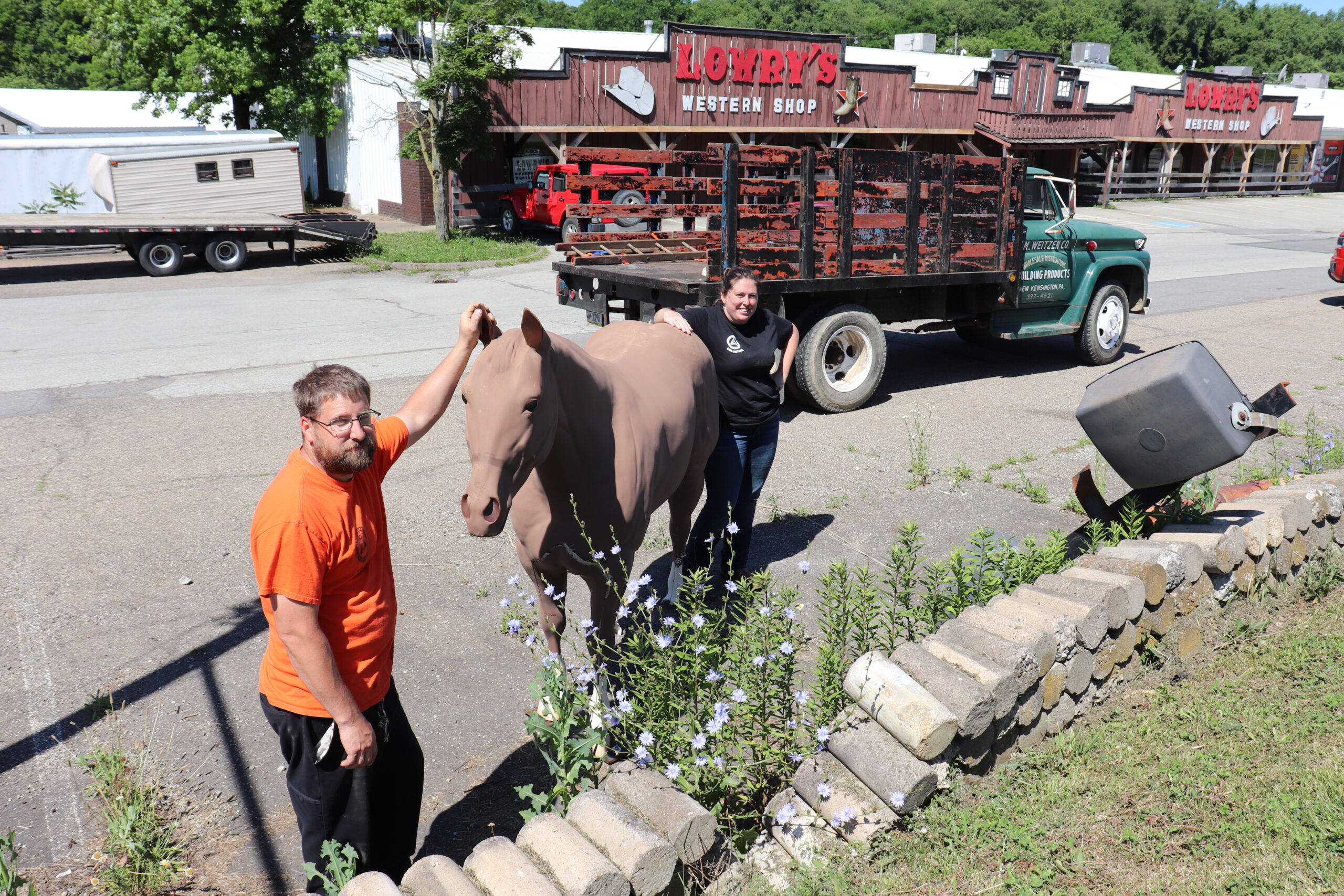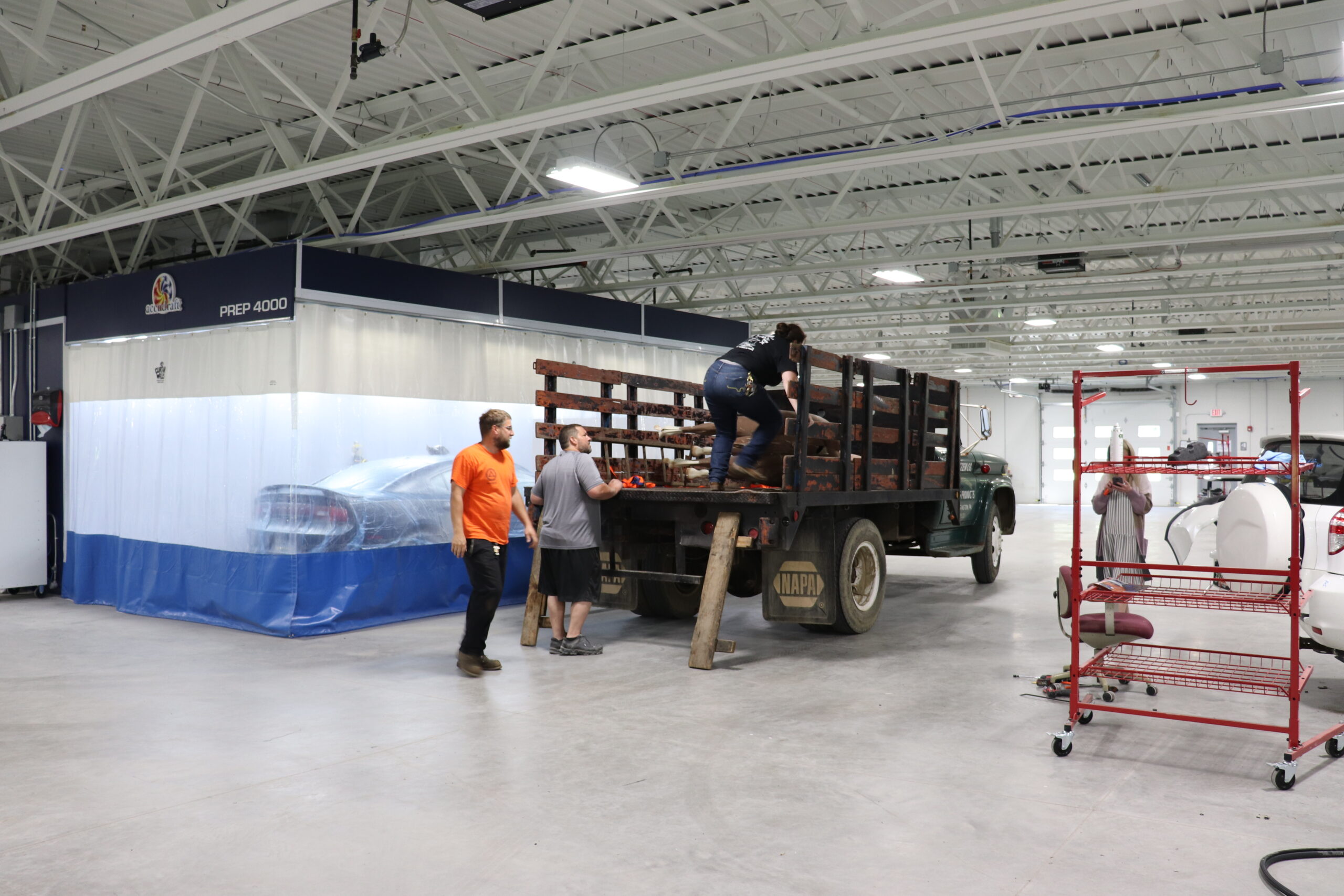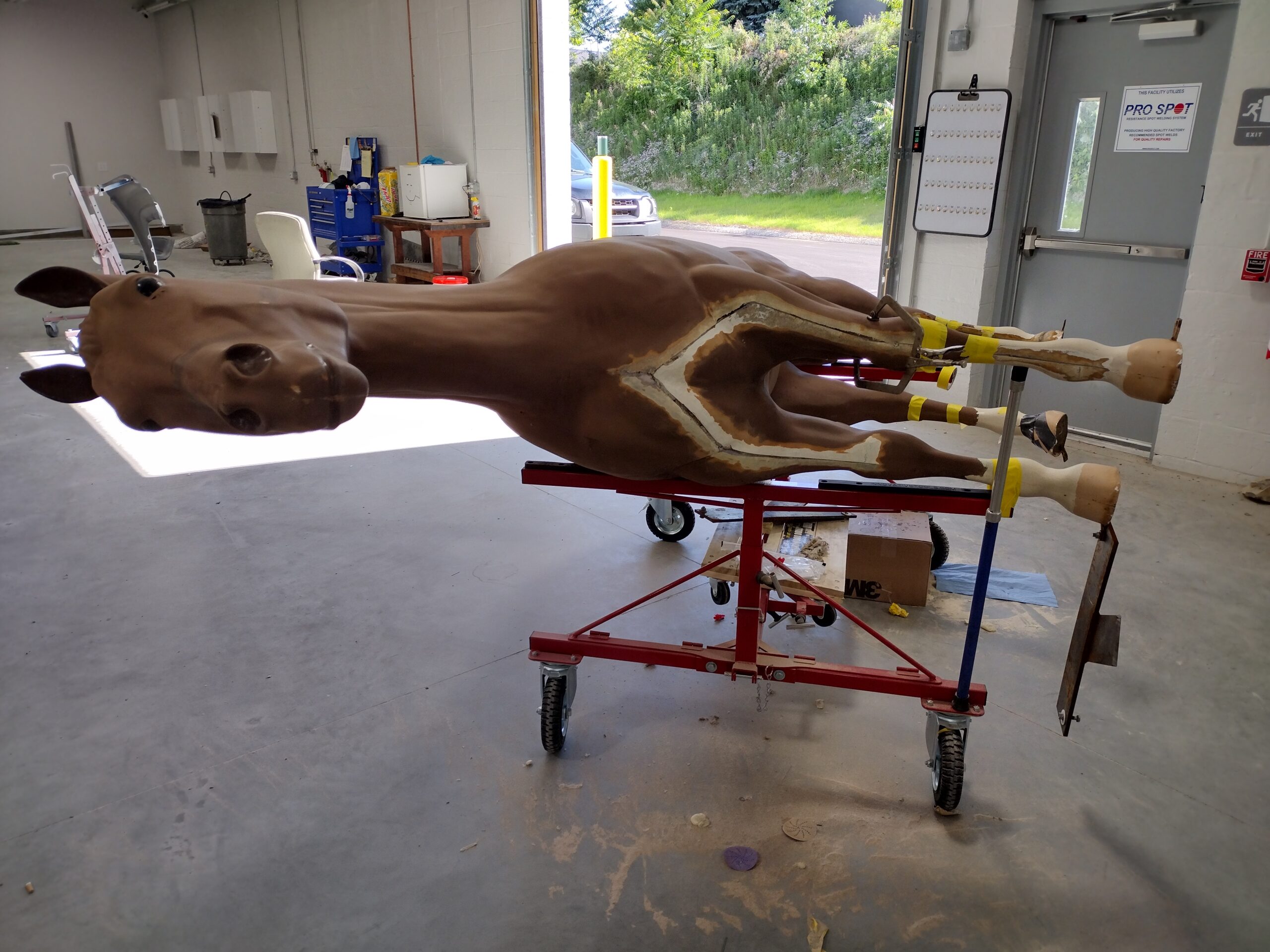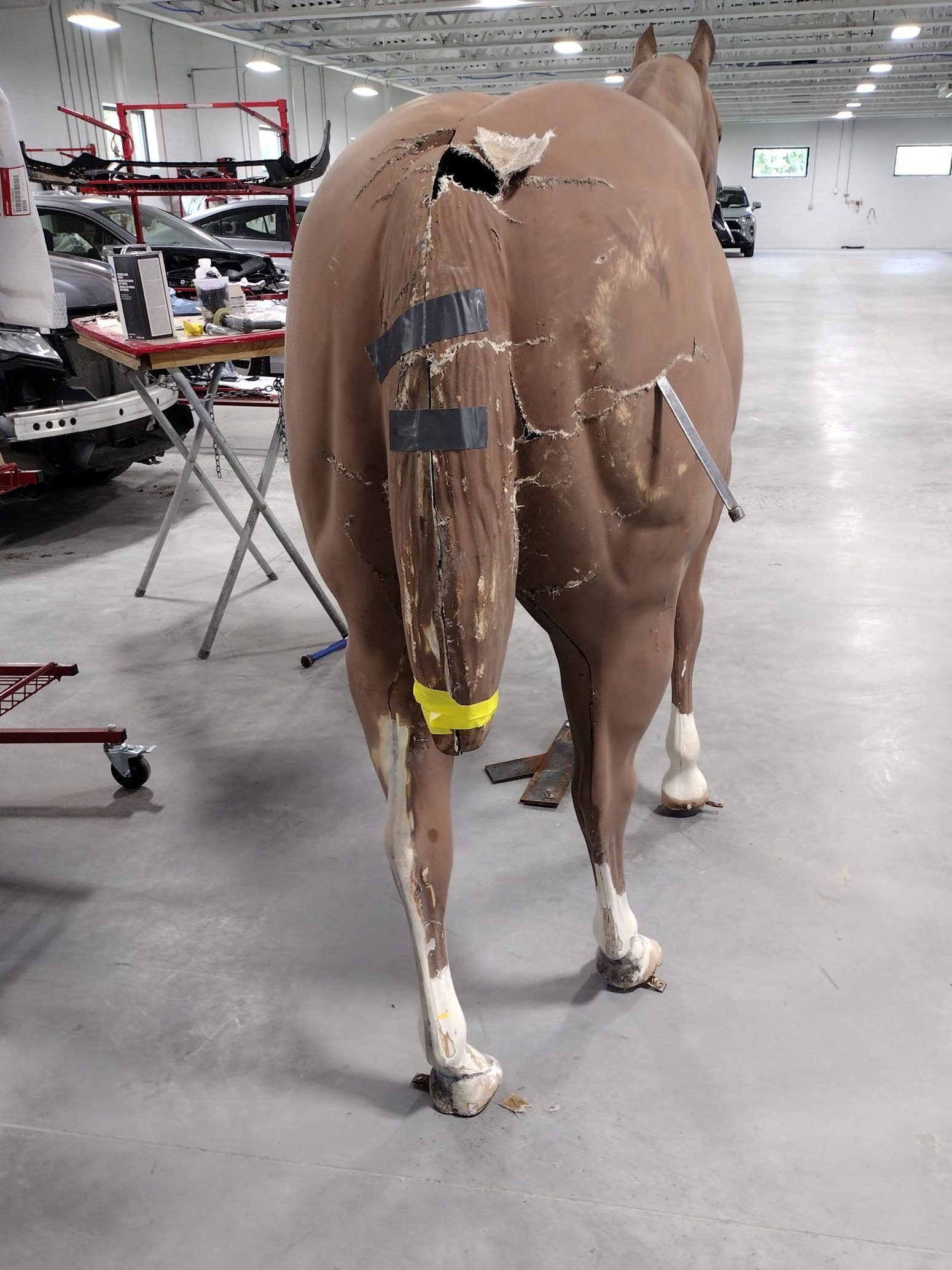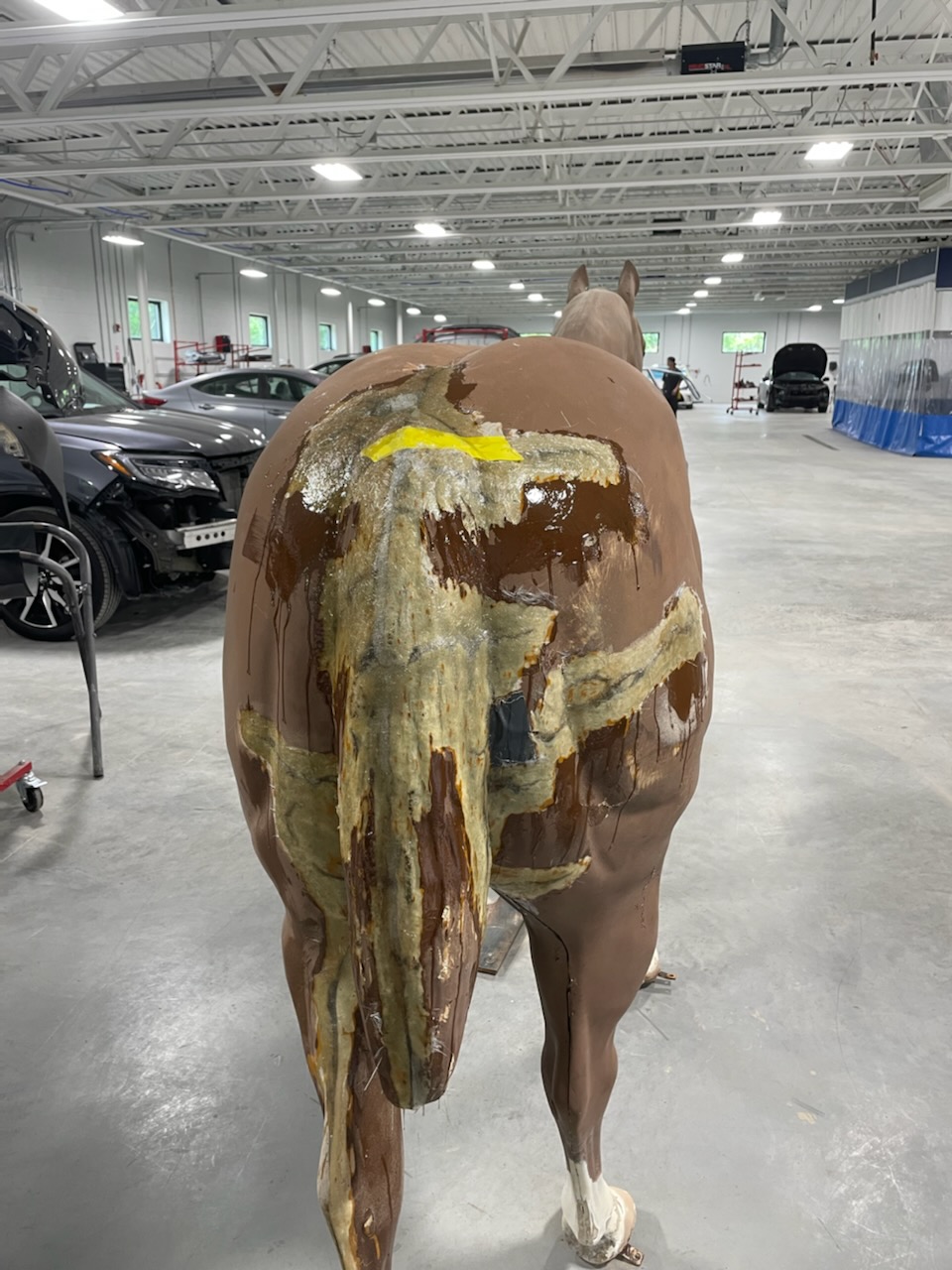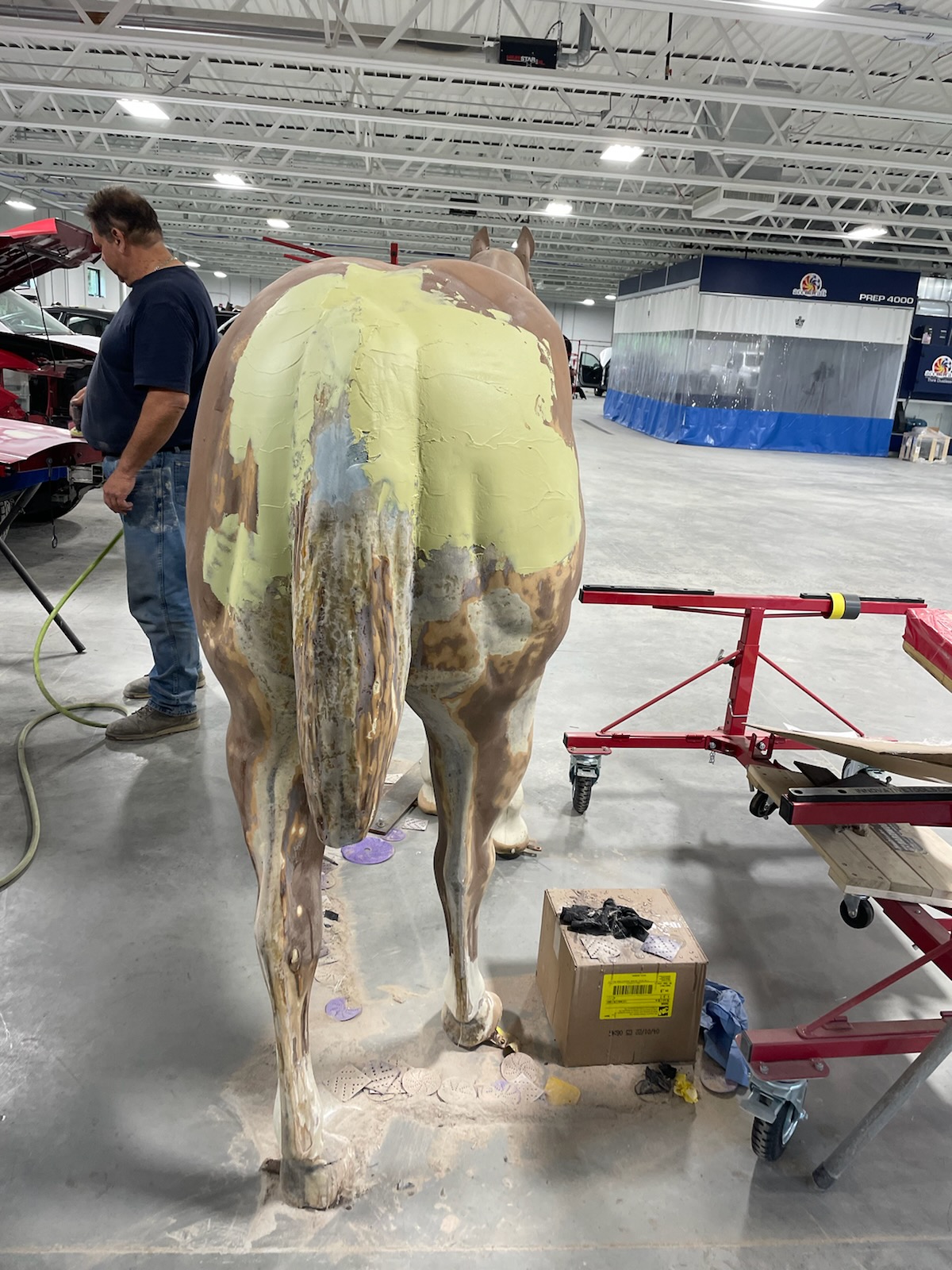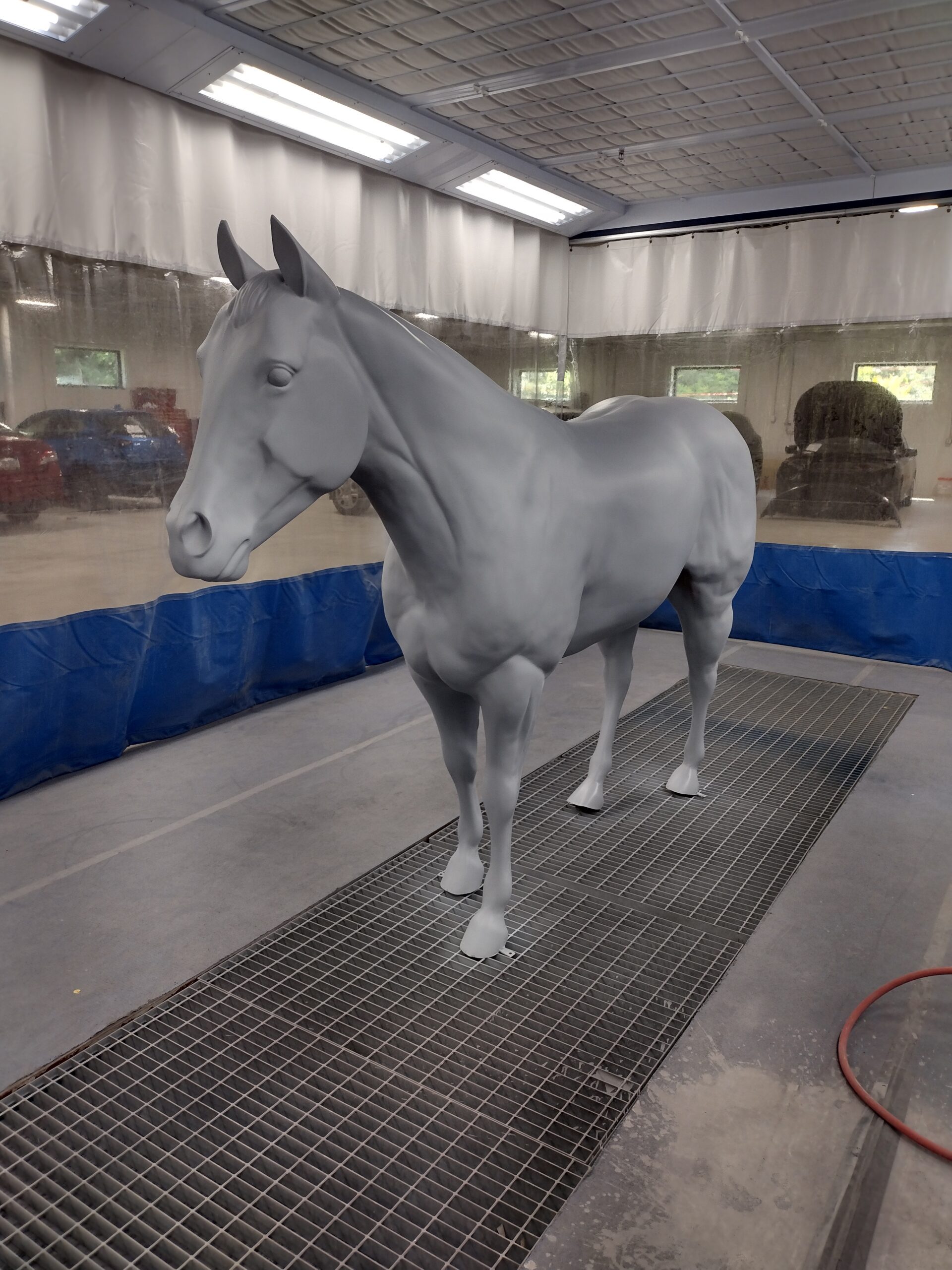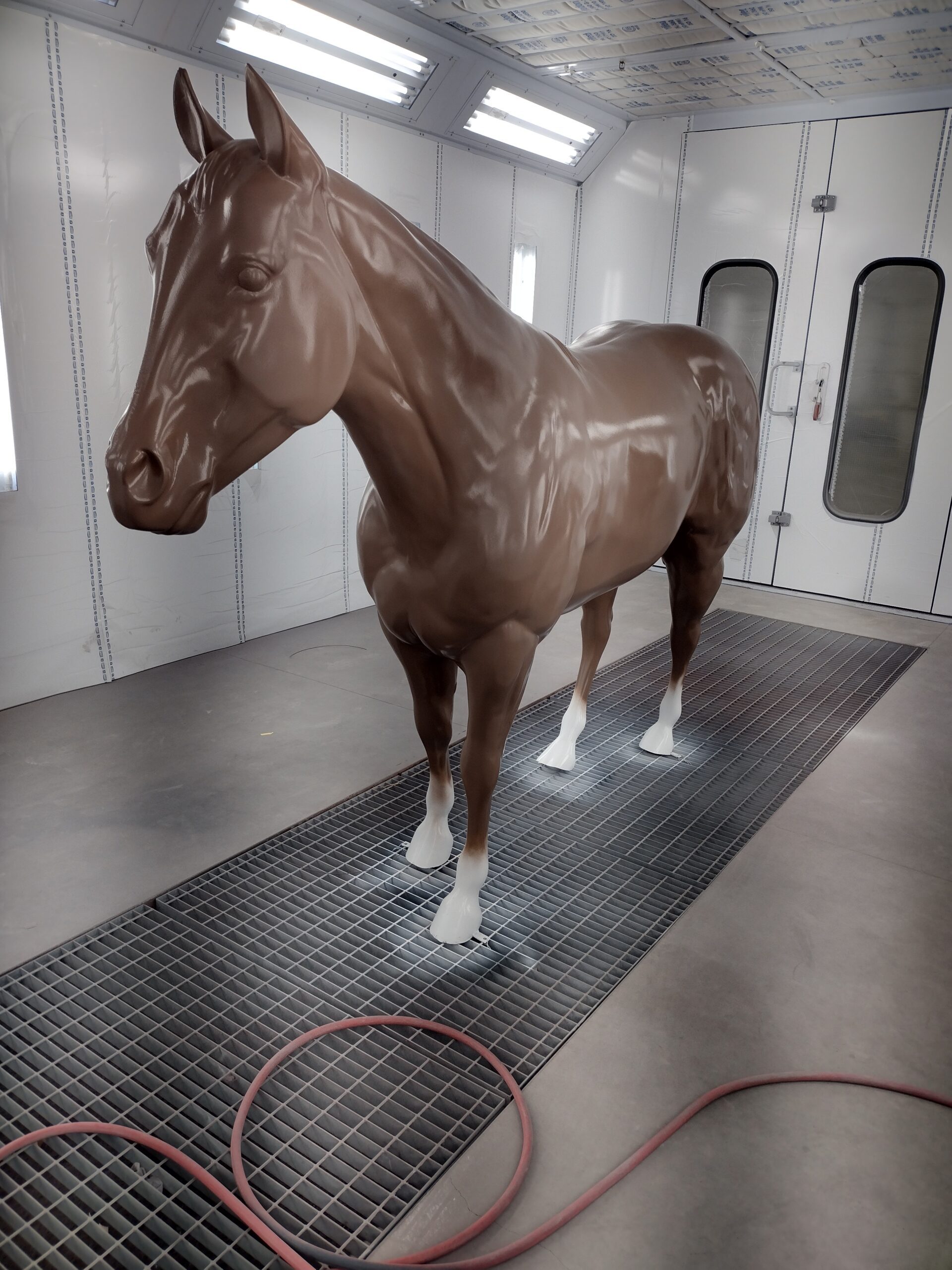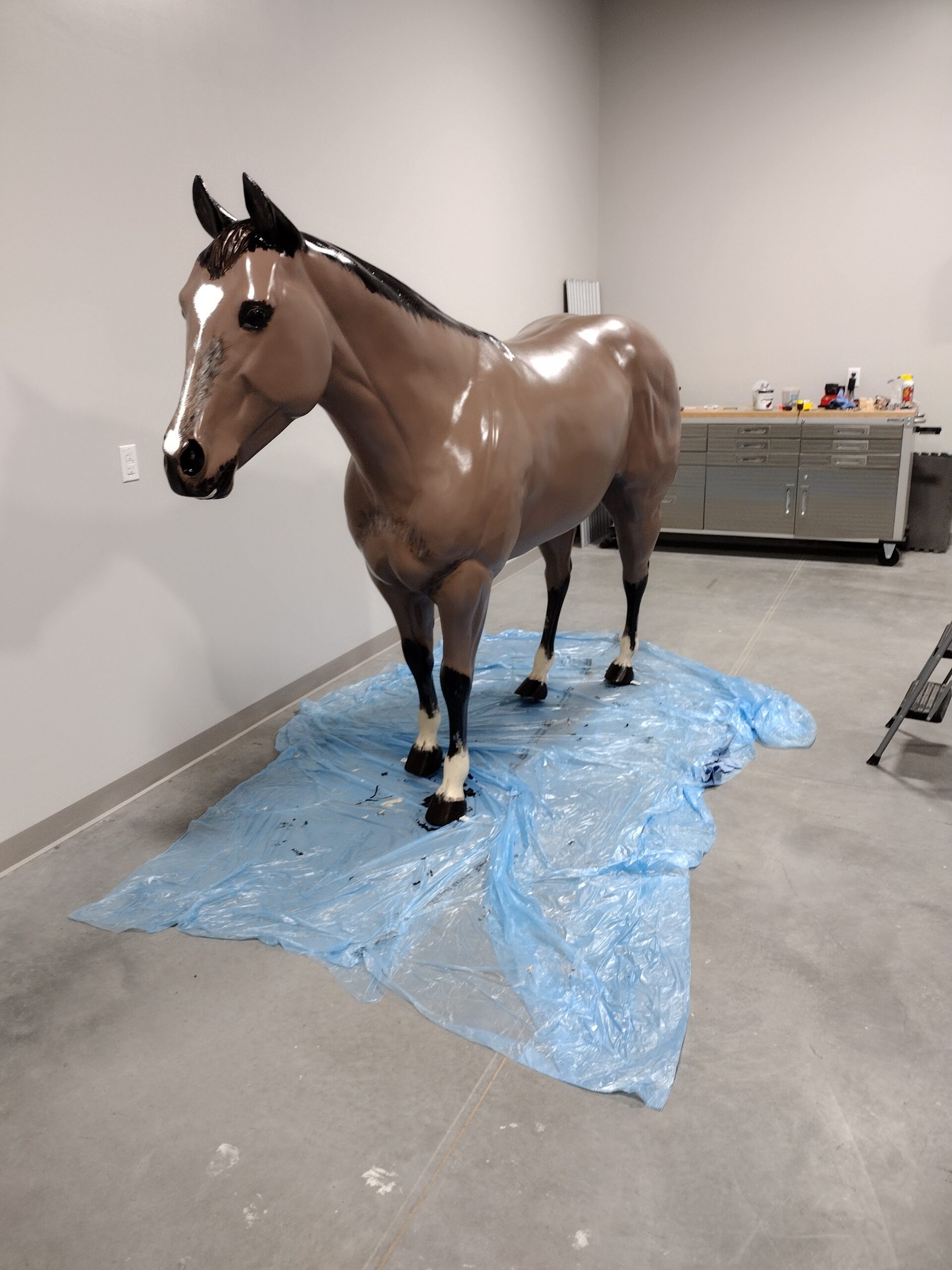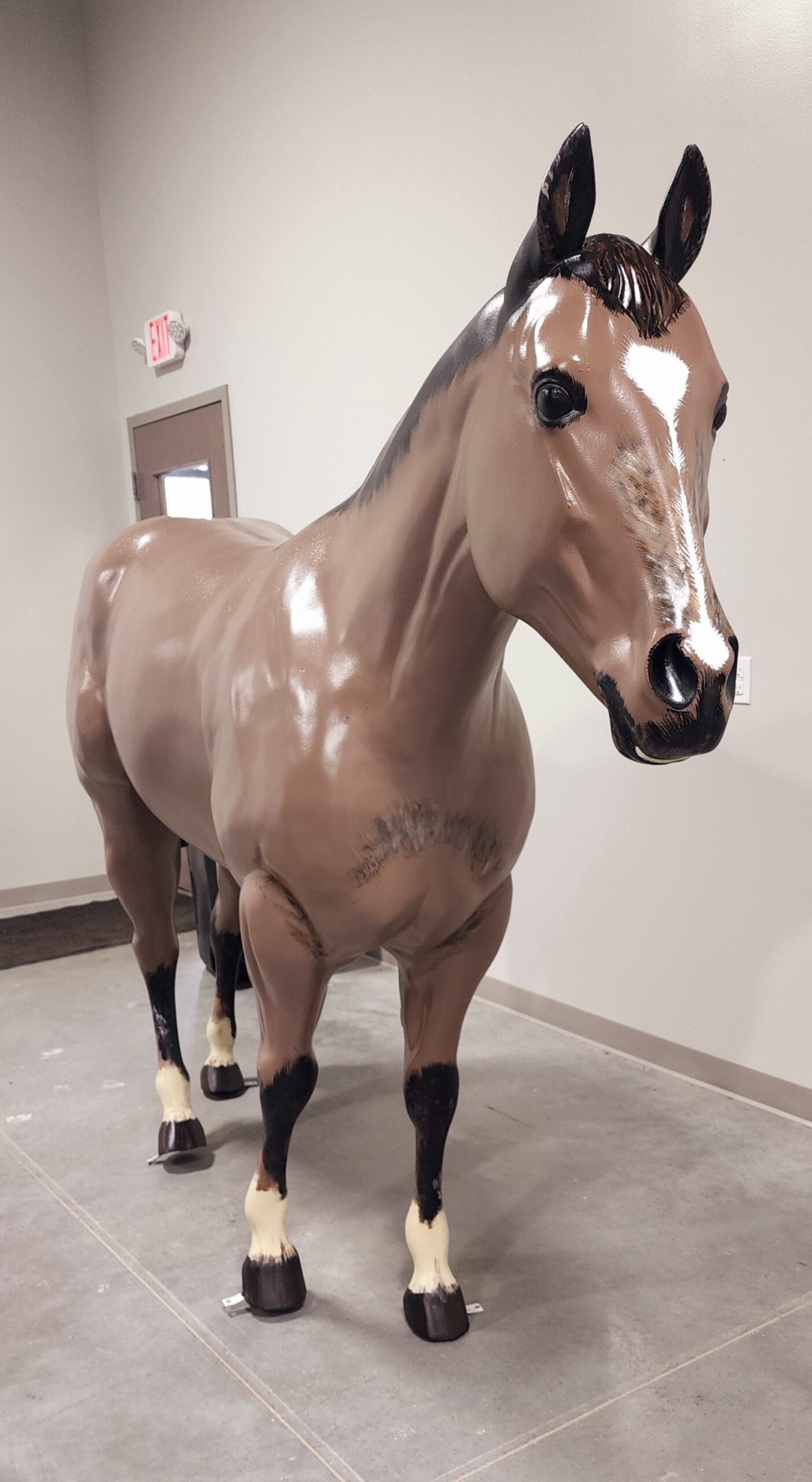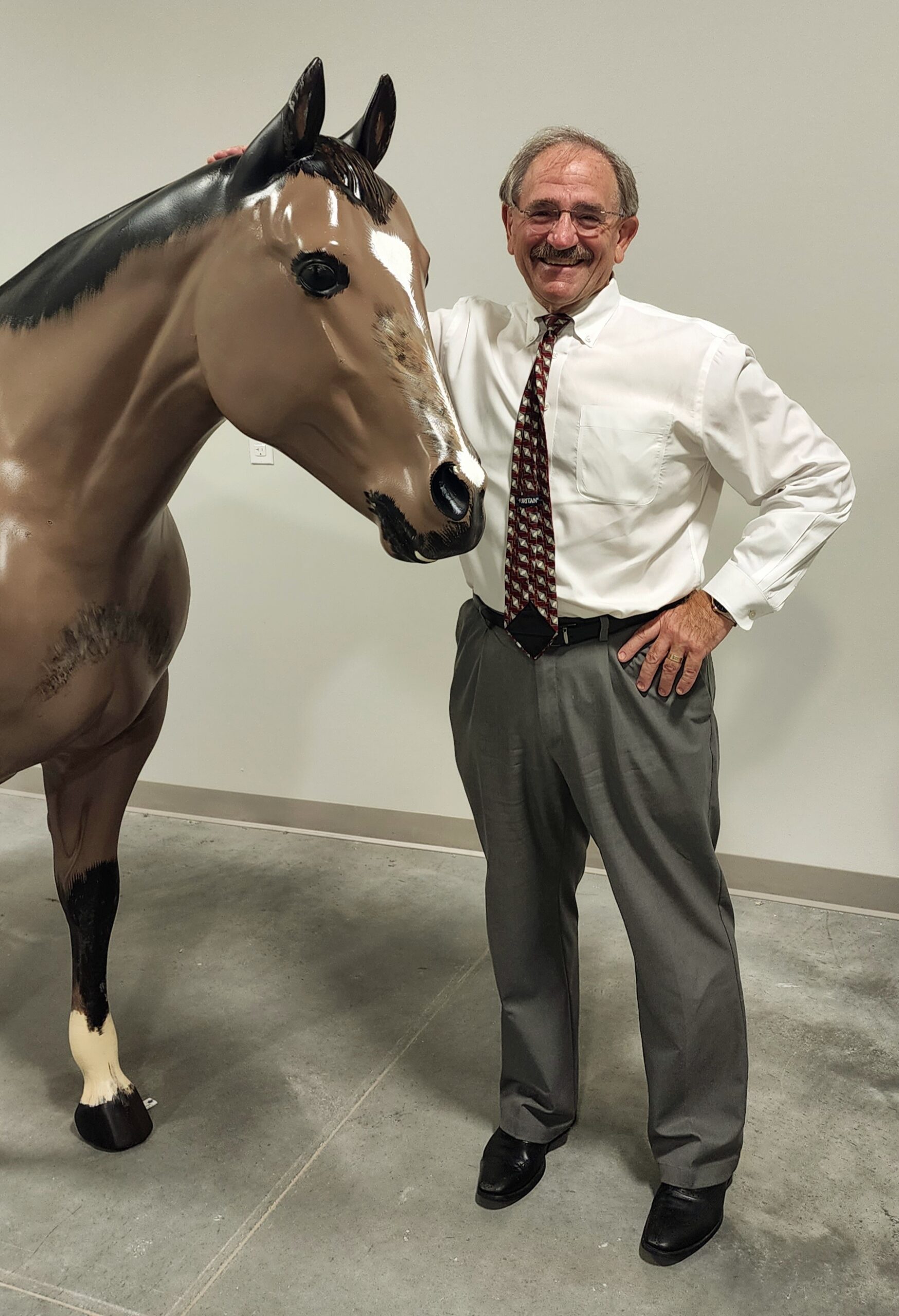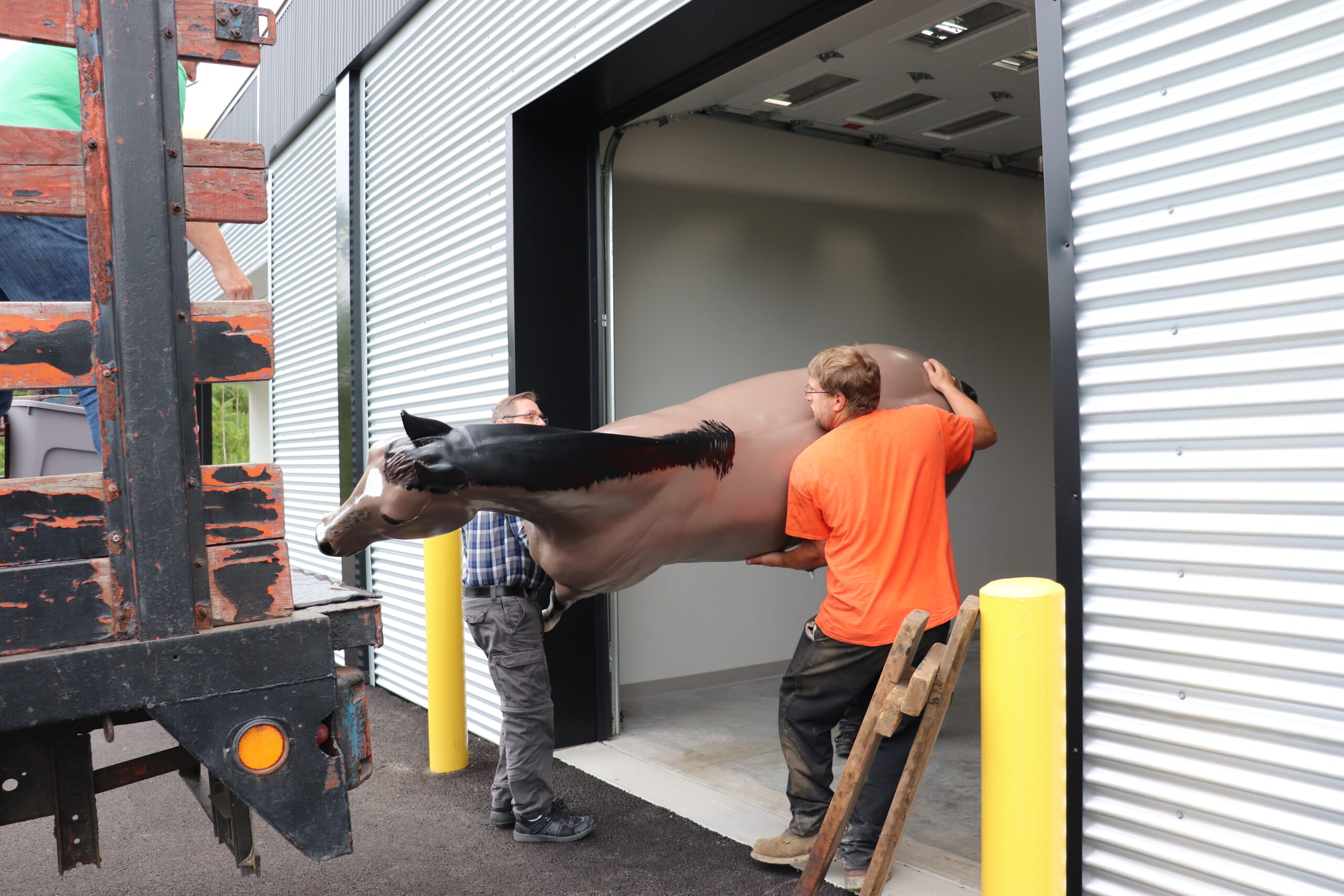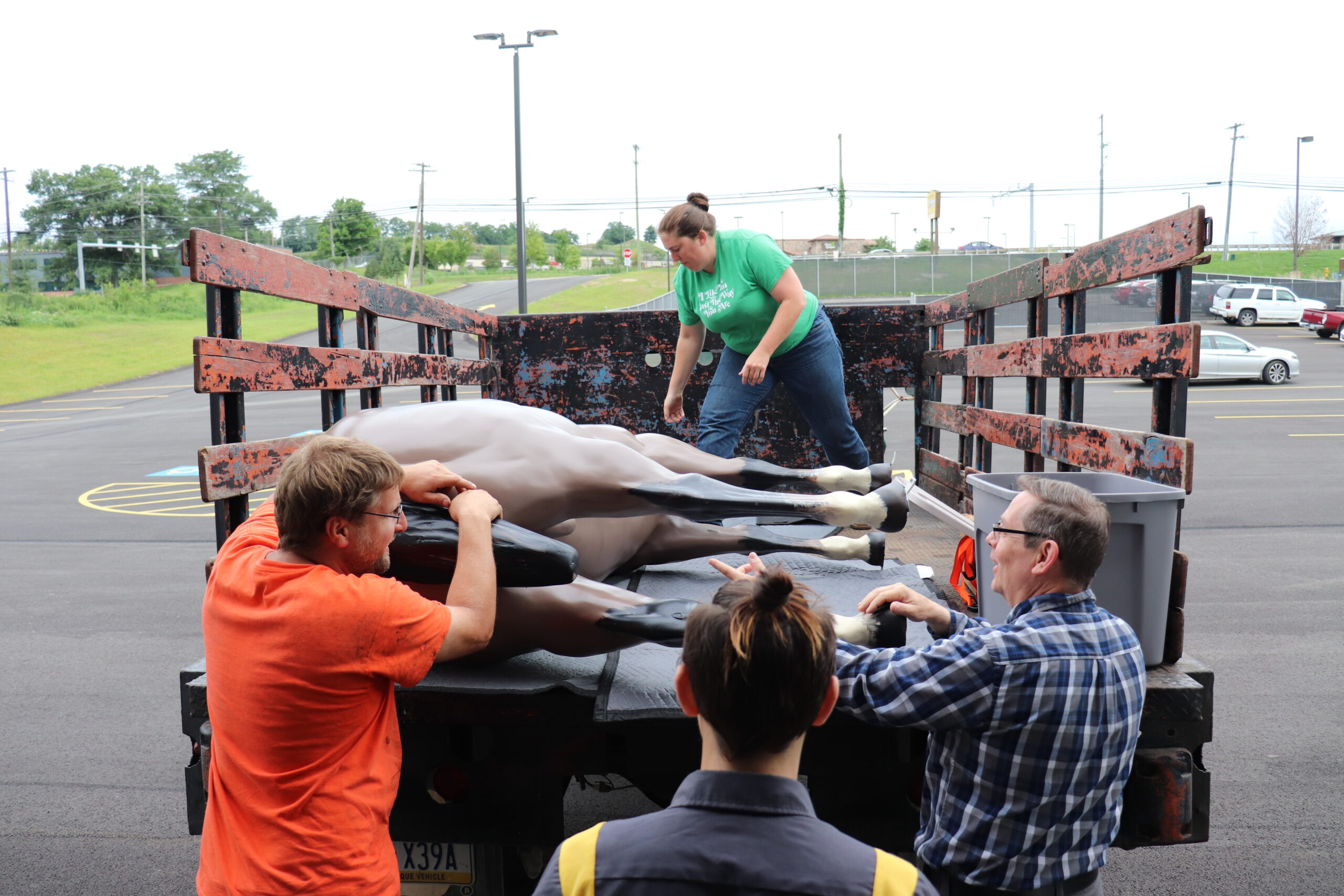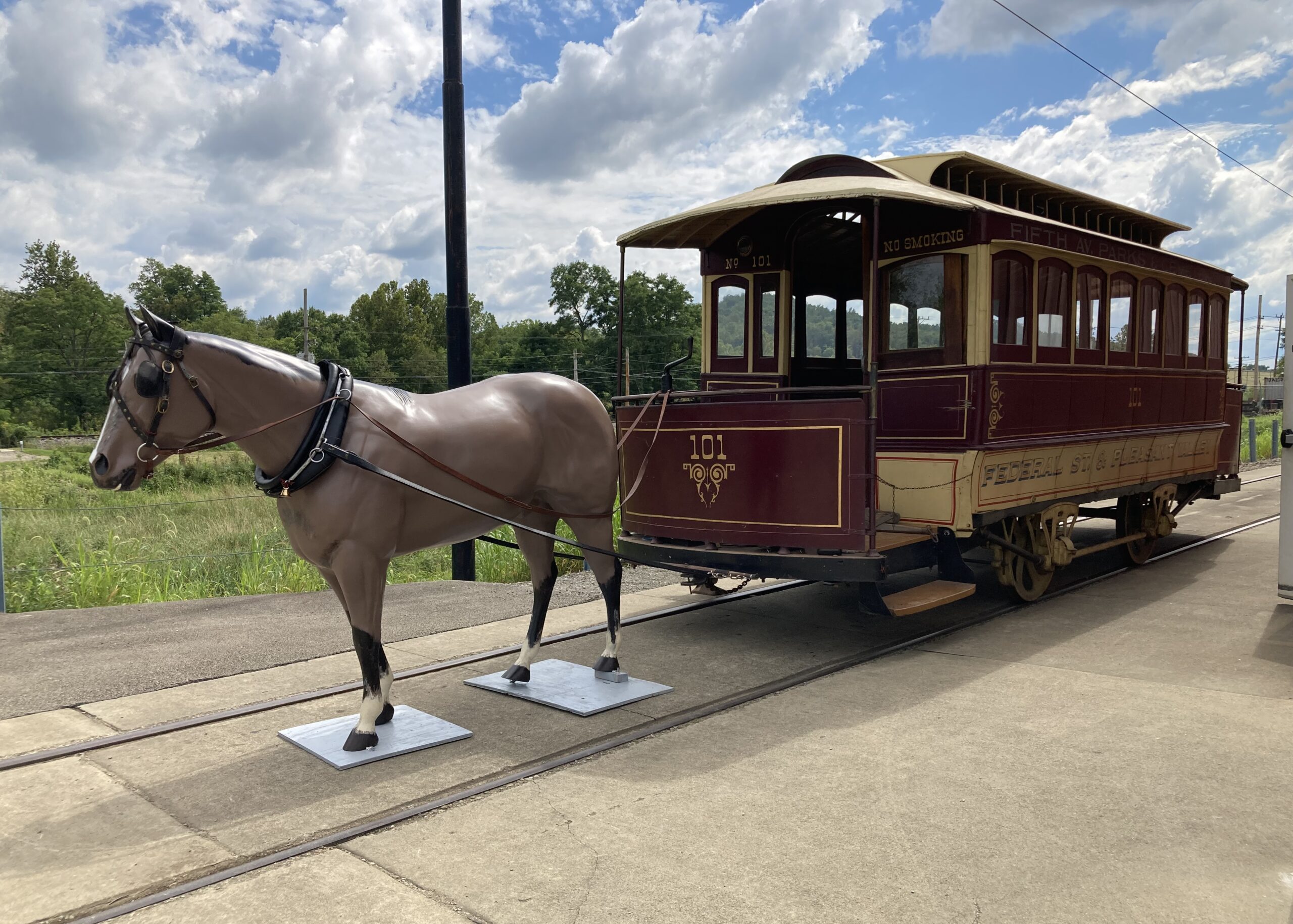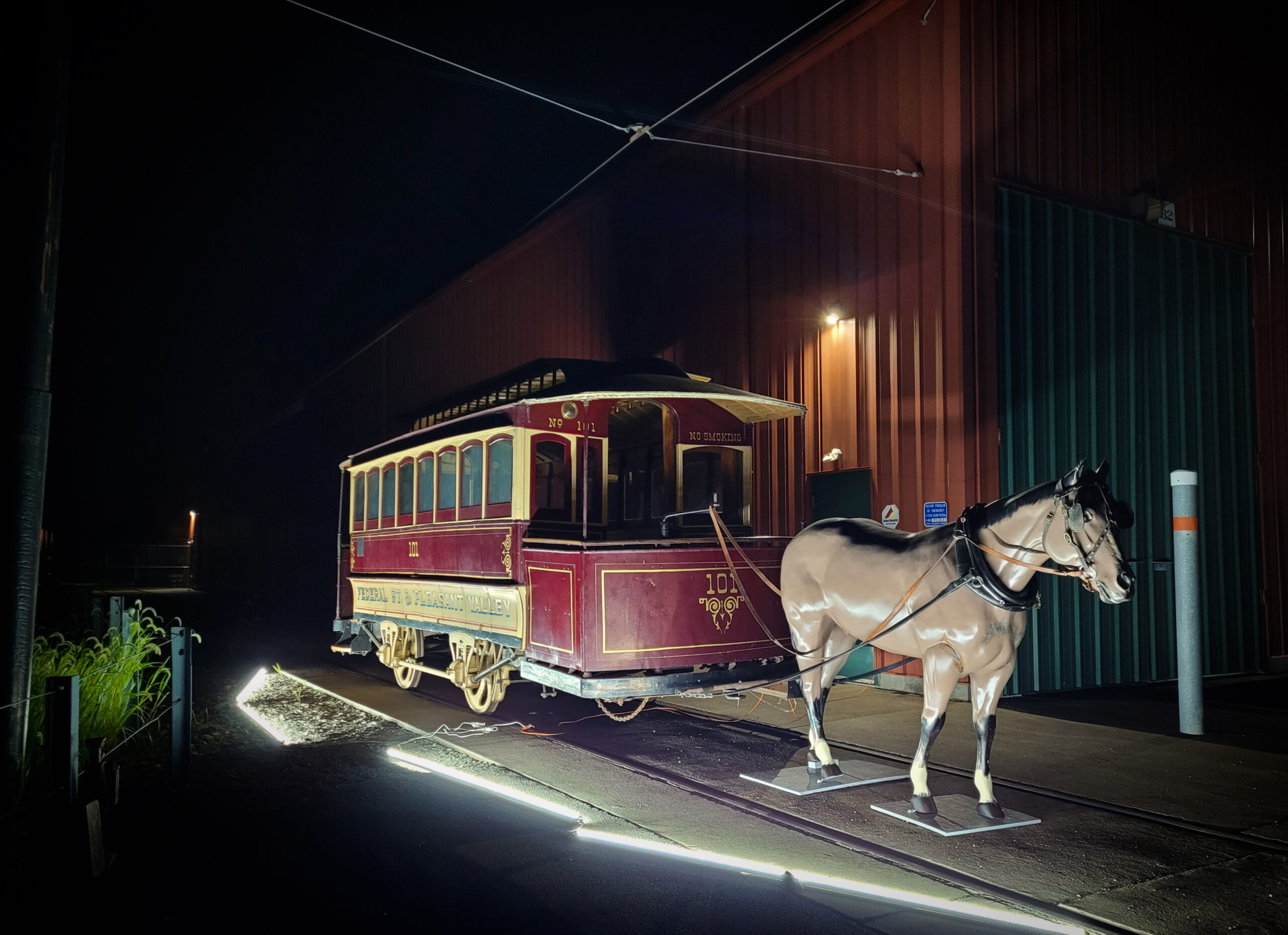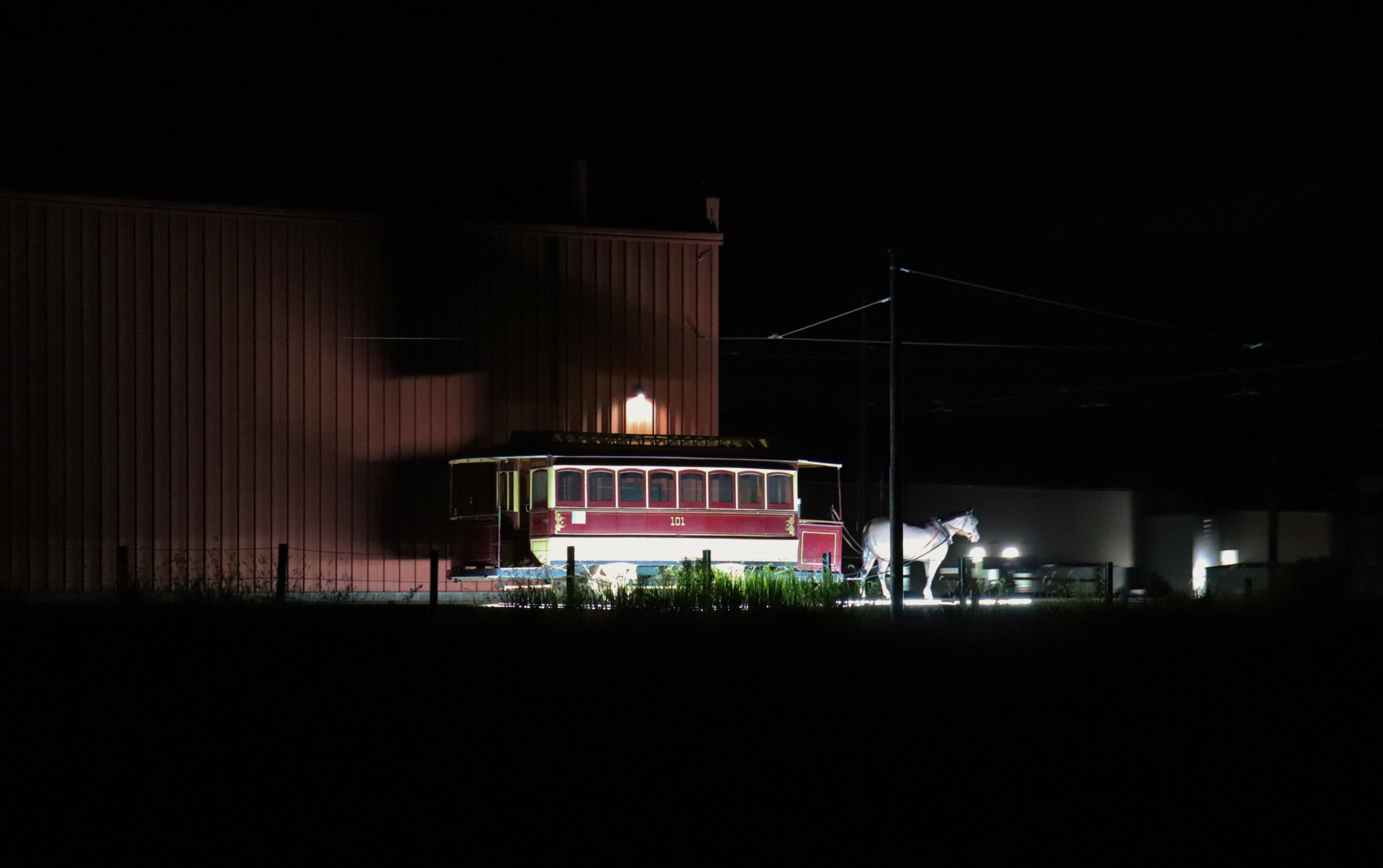Standing high in the air for over 40 years along Henderson Avenue was a brown fiberglass horse advertising Lowry’s Western Shop. In the spring of 2022 during a lunch trip to Countryside Deli next door, a group of Pennsylvania Trolley Museum staff noticed a toppled pole and the aforementioned horse which now lay on the pavement with several severe cracks after an unfortunate run-in with a delivery truck the previous winter.
Saddled with the task of arranging the collection of streetcars to best tell the story of the Trolley Era, several Pennsylvania Trolley Museum volunteers and staff came to the idea of acquiring the damaged horse as a potential exhibit in front of the Museum’s rare 1870s horsecar inside the Trolley Display Building. Executive Director and CEO Scott Becker placed a call to Lowry’s Western Shop, and co-owners Gail Cecchetti and Bill Litman generously agreed to donate the horse.
Horses were very important to the advancement of public transportation — horsecars (streetcars pulled by horses) first appeared in Pittsburgh in the late 1850s and were the first all-weather transit vehicle, moving people through the streets on steel rails rather than in the mud and muck. In fact, Pittsburgh ran horsecars comparatively late — the Sarah Street line was one of the last horsecar lines in the United States when it ceased animal-powered operations in 1923.
The Museum’s own horsecar is a typical example of 1870s Stephenson-built cars that ran to the western end of Allegheny City from Pittsburgh until 1907 when the Union Bridge spanning the Allegheny River was deconstructed after flood damage. Car 101 then spent nearly 100 years as a display piece in various locations including the Exposition Hall in modern day Point State Park, town parades, South Park Fairgrounds, and Station Square. In 2004, the horsecar came to the Museum for permanent display.
The Lowry’s horse needed a few significant repairs before it could take its place as a mane exhibit. Ed Morascyzk, President of PTM’s Board of Trustees and owner of the new Prime Collision Center on Route 19 in South Strabane, saw the opportunity for a fun collaboration between local Washington organizations and donated Prime’s services. General Manager at Prime Collision Center Gary Flannery said it made sense for the body shop to take on the horse project since it was damaged in a vehicle accident, and they do a lot of fiberglass repairs on cars.
Kevin Zebley, with the help of volunteer Sarah Wells, transported the horse from Lowry’s to the body shop in the back of his 1965 GMC stake bed truck to be restored and stable-ized. Following behind on the drive over, Kristen Fredriksen, the Pennsylvania Trolley Museum’s volunteer coordinator, was photographing the horse at a stop light when a man in the car in the next lane rolled down his window and shouted over, “Is it dead?!”
Not for long! Upon delivery to Prime Collision Center (the site of the old Route 19 Bowling Alley), the horse was unloaded and placed on a rack alongside the paint booth in the spotless new facility. The body shop technicians had free reign to do a high-quality cosmetic restoration, and over the next few weeks, Gary Flannery shared photos of the horse in progress. In addition to the cracks in the body, the horse was missing most of its hooves, so fiberglass repairs came first.
Next up came primer, a basecoat, and then paint. Sarah Wells, the Museum’s horse expert and enthusiast, submitted reference photos to Prime Collision Center of typical bay horse coloring and markings. With the horse in the home stretch, Gary’s wife Rose painted the finer details of the mane, hooves, tail, and face to make the horse more realistic.
Sarah finished gathering up the proper tack to display the horse — the fittings are authentic. Soon enough, the Pennsylvania Trolley Museum received notice that the horse was ready to return. Protected by furniture blankets for padding, the horse was carefully loaded up and hauled back to the Museum where it was mounted on sheets of plywood for display.
The horse made its debut during the 2022 Washington County Agricultural Fair. Each morning, a cavalry of volunteers pushed the horsecar out alongside the building and staged the horse ahead of it, spotlighting the scene at night with LED lights. The Museum wanted to harness the excitement of the Fair and draw attention to the improvements in exhibits and facilities; in fact, just beyond the horsecar on display, trolley riders could see the recently-completed steel frame of the future Welcome & Education Center. The emerging building, the intricately painted horsecar, the new four-legged friend, and the cavalcade of streetcars bound for the Fair jockeyed for visitors’ attention.
The Museum invited Lowry’s Western Shop co-owners Gail Cecchetti and Bill Litman to visit the recently-refurbished horse on Friday, August 19, 2022. Both were impressed with the work — the 45-year-old horse now looks brand new again. Bill and Gail, along with Pennsylvania Trolley Museum Executive Director and CEO Scott Becker and Prime Collision Center owner Ed Morascyzk posed on the front platform of the horsecar. After a bit of foal-ing around, Gail and Bill thanked the Museum for their horse-pitality and hoofed it back to their store. From now on, this show pony will greet guests in the Trolley Display Building at the Museum where he hopes to become a colt sensation!
We’ve been champing at the bit to share this story for the past few months – we intend to have a naming contest for the horse in the near future! Stay tuned to the Pennsylvania Trolley Museum’s social media channels for details. We send our gratitude to Prime Collision Center and Lowry’s Western Shop and appreciate their generosity in making this possible!
